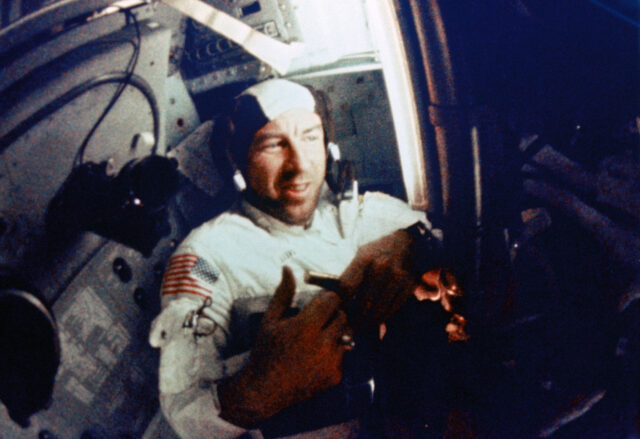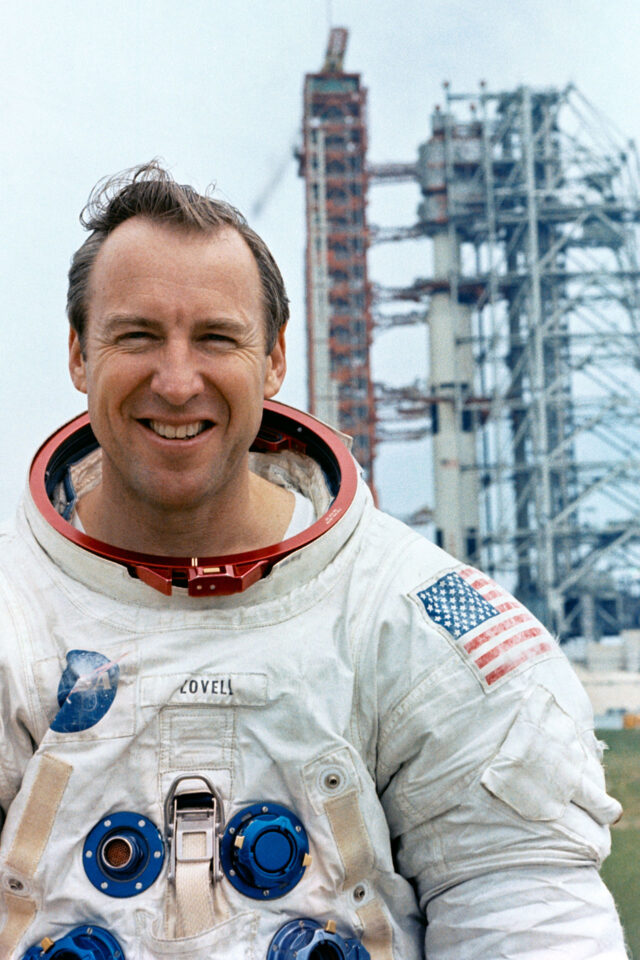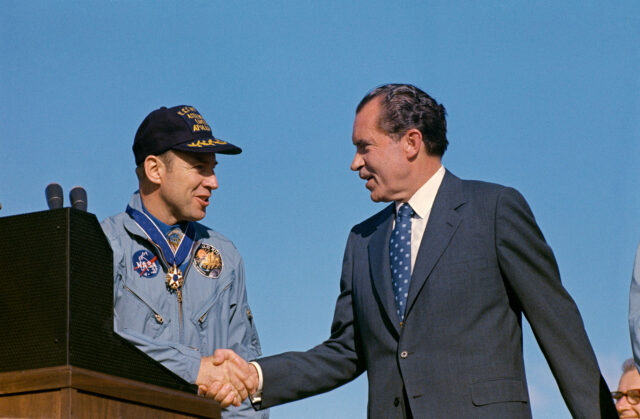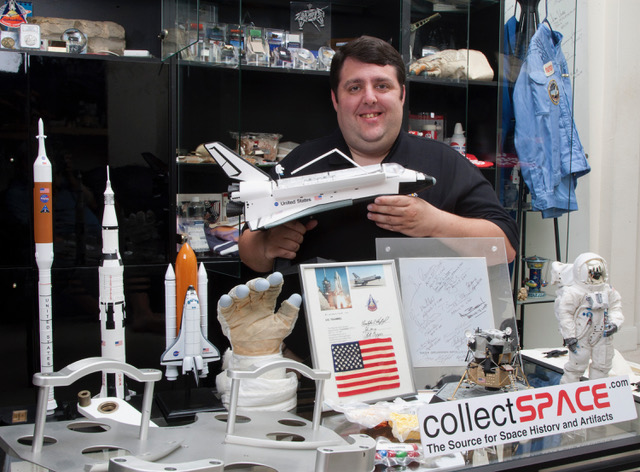Gemini and Apollo astronaut
Lovell was the first person to fly to the Moon twice.
Astronaut Jim Lovell takes a self-portrait aboard NASA's Gemini 12 spacecraft during the final mission of the program in 1966. Credit: NASA
James Lovell, a member of humanity's first trip to the moon and commander of NASA's ill-fated Apollo 13 mission, has died at the age of 97.
Lovell's death on Thursday was announced by the space agency.
"NASA sends its condolences to the family of Capt. Jim Lovell, whose life and work inspired millions of people across the decades," said acting NASA Administrator Sean Duffy in a statement on Friday. "Jim's character and steadfast courage helped our nation reach the moon and turned a potential tragedy into a success from which we learned an enormous amount. We mourn his passing even as we celebrate his achievements."
A four-time Gemini and Apollo astronaut, Lovell was famously portrayed in the 1995 feature film Apollo 13. The movie dramatized his role as the leader of what was originally planned as NASA's third moon landing, but instead became a mission of survival after an explosion tore through his spacecraft's service module.
"I know today when I came out many of you were expecting Tom Hanks, but you're going to have to settle for little old me," Lovell often said at his public appearances after the movie was released.

Astronaut Jim Lovell (right) addressing Tom Hanks at the premiere of Apollo 13: The IMAX Experience at the Kennedy Space Center Visitor Complex in November 2002. Credit: collectSPACE.com
Practicing for the moon
Selected with NASA's second group of astronauts in 1962, Lovell first launched aboard Gemini 7, the first mission to include a rendezvous with another crewed spacecraft (Gemini 6). Lifting off on a Titan II rocket on December 4, 1965, Lovell and the mission's commander, Frank Borman, had one goal: to spend two weeks in Earth orbit in preparation for the later Apollo missions to the moon.
"It was very exciting to me," said Lovell in a 1999 NASA oral history interview. "I mean, it was tedious work, you know, two weeks. We did have a break when [Wally] Schirra and [Tom] Stafford came up [on Gemini 6] and rendezvoused with us. And then they were up, I think, 24 hours and they went back down again. And we stayed up there for the full time. But it was quite rewarding."
At 13 days, 18 hours, 35 minutes and one second, Gemini 7 was the longest space flight until a Russian Soyuz mission surpassed it in 1970. Lovell and Borman continued to hold the US record until the first crewed mission to Skylab, the nation's first space station, in 1973.
Lovell then commanded Gemini 12, the final flight of the program, which launched on November 11, 1966. Only four days long, the mission stood out for demonstrating all of the skills needed to send astronauts to the moon, including rendezvousing and docking with an Agena target and the first successful spacewalks conducted by crewmate Buzz Aldrin.
"Buzz completed three spacewalks of about 5.5 hours and everything was fine," said Lovell. "[We did] everything we were supposed to do, and [had] no problem at all. So, it was a major turning point in the ability to work outside a spacecraft."
First and fifth
Lovell made his first trip to the moon as a member of the first-ever crew to fly to another celestial body. Reunited with Borman and joined by William "Bill" Anders, Lovell launched on Apollo 8 on December 21, 1968. The mission was also the first crewed flight of the Saturn V, the massive rocket designed to send astronauts from Earth to the moon.
"You had to pinch yourself," Lovell said of the journey out. "Hey, we're really going to the moon!" I mean, "You know, this is it!"

A still from a 16mm motion picture film shows Jim Lovell during the Apollo 8 mission, the first flight by humans to the moon. Credit: NASA
Lovell and his Apollo 8 crewmates were the first to see the far side of the moon with their own eyes and the first to witness "Earthrise"—the sight of our home planet rising above the lunar horizon—their photographs of such were later credited with inspiring the environmental movement.
"We were so curious, so excited about being at the moon that we were like three school kids looking into a candy store window, watching those ancient old craters go by from—only 60 miles [97 kilometers] above the surface," said Lovell.
Splashing down on December 27, 1968, the Apollo 8 mission brought to a close a year that had otherwise been troubled with riots, assassinations, and an ongoing war. A telegram sent to the crew after they were home said, "You saved 1968."
"I was part of a thing that finally gave an uplift to the American people about doing something positive, which was really—that's why I say Apollo 8 was really the high point of my space career," said Lovell.
Even before launching on Apollo 13 on April 11, 1970, Lovell had decided it was going to be his last. At 42, he was the first person to launch four times into space. Had the flight gone to plan, he would have become the fifth person to walk on the moon and the first to wear red commander stripes while do so.

Jim Lovell, commander of the Apollo 13 mission, poses for a photo with his Saturn V rocket on the launch pad in April 1970. Credit: NASA
Instead, there was a "problem."
"I don't know why I did this, but I looked out the right window, and that's when I saw that at a high rate of speed, gas was escaping from the spacecraft. You could see a little plume of it," said Lovell in an April 2000 interview with collectSPACE. "I then glanced at the oxygen gauges and one read zero and another was in the process of going down."
"That is when I really felt we were in a very dangerous situation," he said.
Lovell and his Apollo 13 crewmates Fred Haise and John "Jack" Swigert splashed down safely on April 17, 1970. In total, Lovell logged 29 days, 19 hours and three minutes on his four spaceflights.
Lovell was the 22nd person to enter orbit, and the 28th to fly into space, according to the Association of Space Explorers' Registry of Space Travelers.
From the cockpit to the board
Born on March 25, 1928, in Cleveland, Ohio, Lovell achieved Eagle Scout as a member of the Boy Scouts and studied engineering as part of the US Navy's "Flying Midshipman" program at the University of Wisconsin in Madison from 1946 to 1948. Four years later, he was commissioned as an ensign and graduated with a Bachelor of Science degree from the Naval Academy in Annapolis, Maryland.
Lovell reported for flight training at Naval Air Station Pensacola in October 1952, and he was designated a naval aviator on February 1, 1954. He served at Moffett Field in Northern California and logged 107 deck landings during a deployment aboard the aircraft carrier USS Shangri-La.
In July 1958, Lovell graduated at the top of the class at the Naval Air Test Center (today, the US Naval Test Pilot School) at Naval Air Station Patuxent River in Maryland. He was one of 110 candidates to be considered for NASA's original Mercury 7 astronauts but was turned away due to a temporary medical concern. Instead, Lovell became the program manager for the McDonnell Douglas F-4 Phantom II supersonic jet.
In 1962, Lovell was serving as a flight instructor and safety engineering officer at Naval Air Station Oceana in Virginia Beach when he was chosen for the second class of NASA astronauts, the "Next Nine."
In addition to his prime crew assignments, Lovell also served on the backup crews for the Gemini 4, Gemini 9, and Apollo 11 missions, the latter supporting Neil Armstrong as backup commander. He also served on a panel studying what could be done in case of an in-flight fire after a fire on the launch pad claimed the lives of the Apollo 1 crew in 1967.
After the Apollo 13 mission, Lovell was named the deputy director of science and applications at NASA's Manned Spacecraft Center (today, Johnson Space Center) before retiring from both the space agency and Navy on March 1, 1973. Lovell became chief executive officer of Bay-Houston Towing Company in 1975 and then president of Fisk Telephone Systems in 1977.
On January 1, 1981, Lovell joined Centel Corporation as group vice president for business communications systems and, 10 years later, retired as executive vice president and a member of the company's board of directors.
For 11 years, from 1967 to 1978, Lovell served as a consultant and then chairman of the Physical Fitness Council (today, the President's Council on Sports, Fitness and Nutrition). He was a member of the board for several organizations, including Federal Signal Corporation in Chicago from 1984 to 2003 and the Astronautics Corporation of America in Milwaukee from 1990 to 1999. He was also chairman of the Astronaut Scholarship Foundation from 1997 to 2005.
Appearances and awards
From 1999 to 2006, Lovell helped run "Lovell's of Lake Forest," a restaurant that he and his family opened in Illinois. (The restaurant was then sold to Jay, Lovell's son, but ultimately closed in 2015.)
In 1994, Lovell worked with Jeffrey Kluger to publish Lost Moon: The Perilous Voyage of Apollo 13, which was later retitled Apollo 13 after serving as the basis for the Ron Howard movie.
In addition to being played by Hanks and having a cameo in Apollo 13, Lovell was also portrayed by Tim Daly in the 1998 HBO miniseries From the Earth to the Moon and Pablo Schreiber in the 2018 Neil Armstrong biopic First Man. Lovell also made a cameo appearance in the 1976 movie The Man Who Fell to Earth.

Jim Lovell, Apollo 13 commander, shakes hands with President Richard Nixon after being presented with the Presidential Medal of Freedom at Hickham Air Force Base, Hawaii, in 1970. Credit: NASA
For his service to the US space program, Lovell was awarded the NASA Distinguished Service and Exceptional Service medals; the Congressional Space Medal of Honor, and Presidential Medal of Freedom. As a member of the Gemini 7, Gemini 12, and Apollo 8 crews, Lovell was bestowed the Harmon International Trophy three times and, with his Apollo 8 crewmates, the Robert J. Collier and Dr. Robert H. Goddard Memorial trophies and was named Time Magazine's Man of the Year for 1968.
Lovell was inducted into the International Space Hall of Fame in 1982, the US Astronaut Hall of Fame in 1993, and National Aviation Hall of Fame in 1998.
A crater on the far side of the moon was named for Lovell in 1970. In 2009, he was awarded a piece of the moon as part of NASA's Ambassador of Exploration Award, which Lovell placed on display at the Patuxent River Naval Air Museum in Lexington Park, Maryland.
A statue of Lovell with his two Apollo 13 crewmates stands inside the Saturn V building at Johnson Space Center's George W.S. Abbey Rocket Park in Houston.
Lovell’s legacy
In 2005, Lovell donated his personal collection of NASA memorabilia to the Adler Planetarium in Chicago, where it is on display in the "Mission Moon" exhibition.
With Lovell's death, only five out of the 24 people who flew to the moon during the Apollo program remain living (Buzz Aldrin, 95; Fred Haise, 91; David Scott, 93; Charlie Duke, 89; and Harrison Schmitt, 90).
Lovell is survived by his children, Barbara Harrison, James Lovell III, Susan Lovell, and Jeffrey Lovell; 11 grandchildren; and nine great-grandchildren. Lovell was preceded in death by his wife Marilyn Lovell and parents James Lovell, Sr, and Blanche Lovell (Masek).
"We are enormously proud of his amazing life and career accomplishments, highlighted by his legendary leadership in pioneering human space flight," said Lovell's family in a statement. "But, to all of us, he was dad, granddad and the leader of our family. Most importantly, he was our hero. We will miss his unshakeable optimism, his sense of humor and the way he made each of us feel we could do the impossible. He was truly one of a kind."
A memorial service and burial will be held at the Naval Academy in Annapolis on a date still to be announced.
Robert Pearlman is a space historian, journalist and the founder and editor of collectSPACE, a daily news publication and online community focused on where space exploration intersects with pop culture. He is also a contributing writer for Space.com and co-author of "Space Stations: The Art, Science, and Reality of Working in Space” published by Smithsonian Books in 2018. He is on the leadership board for For All Moonkind and is a member of the American Astronautical Society's history committee.











 English (US) ·
English (US) ·